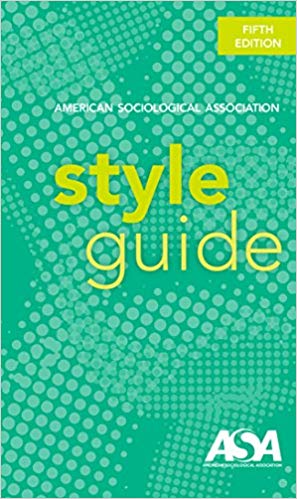-
4-minute read
-
1st October 2019
What Is ASA Referencing? 5 Key Facts
If you’re studying sociology, you may have been asked to use ASA referencing in your written work. But what exactly is ASA referencing and how does it work? In this post, we look at the basics of this system.
1. What Is ASA Referencing?

ASA referencing is a citation style used in the social sciences. The ‘ASA’ stands for ‘American Sociological Association’, who publish the ASA Style Guide. As well as setting out a referencing system, this guide explains how to prepare a research paper for ASA journals. The referencing style, however, is also used by other academic publishers and universities.
2. ASA Citation Style
ASA referencing uses author–date citations, similar to those used in APA referencing. However, the exact citation style is a little different so be careful not to get these confused. The basic ASA style involves giving an author’s surname and a publication year in brackets, although you can just cite the year if the author is named in the text:
Social interactions rely on insider knowledge (Buxton 2010). On top of this, Cornish (1991) says that society depends on such shared understandings.
In the example above, we cite a source by ‘Buxton’ from the year 2010 and one by Cornish from 1991. Notice that there is no comma separating the name from the year in the first citation.
3. Citing More than One Author
If you are citing a source with two authors, include both names in the citation:
Pair bonding is vital to social cohesion (Cornish and Buxton 2008).
Always use ‘and’ when there is more than one author to cite, not the ‘&’ symbol. When a source has three authors, you should still name all of them in the first citation. After that, though, you can shorten repeat citations to just the first author’s name plus ‘et al.’ as follows:
Martin, Chase and Short (1986) argue that three is a crowd. However, such crowds play an important social function (Martin et al. 1986).
If a source has four or more authors, you should just cite the first author plus ‘et al.’ in all citations, including the first one.
4. Quoting Sources in ASA Referencing
When quoting a source directly, include a page number after a colon:
Find this useful?
Subscribe to our newsletter and get writing tips from our editors straight to your inbox.
Subscribe to Beyond the Margins and get your monthly fix of editorial strategy, workflow tips, and real-world examples from content leaders.
Economic factors are ‘key to social theory’ (Sayle 2017:48).
Here, for example, we’re citing page 48 of a source. Note that there is no space between the colon and the page number, nor is there a ‘p.’ before the page number. This style changes when the author is named in the text.
When this happens, cite the year immediately after the author’s name, but give the page number after the quotation:
Sayle (2017) argues that economic factors are ‘key to social theory’ (p. 48).
As above, then, we include ‘p.’ when a page number is cited separately.
5. ASA References and Reference List Rules
At the end of your document, provide full publication information for each source cited. The rules for compiling an ASA reference list are as follows:
- List references in a new section titled ‘References’.
- Only list sources you have cited in the main text of your paper.
- List references alphabetically by author surname.
- Give the first named author’s surname first (e.g. Smith, John).
- Give other authors’ names in the conventional order (e.g. John Smith).
- Use italics for book and journal titles (and other long-form sources).
- Use quotation marks around the titles of articles and other short sources.
- When citing more than one source by the same author, arrange them by year of publication and use six hyphens followed by a full stop in place of the author’s name for each entry after the first.
- In each entry, add a half-inch hanging indent for each line after the first.
The exact format to use in the reference list will depend on the source type. The key in all cases, however, is to provide enough information to identify the exact source used. The entry for a book, for example, would look like this:
Smith, John. 2001. The Basics of ASA Referencing. New York: Proofed Publications.
Here, we have the author’s surname, a year of publication, the title, a place of publication and the name of the publisher. This will allow anyone who reads the list to find the book in question.




